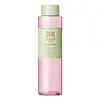What's inside
What's inside
 Key Ingredients
Key Ingredients

 Benefits
Benefits

 Concerns
Concerns

No concerns
 Ingredients Side-by-side
Ingredients Side-by-side

Water
Skin ConditioningRosa Damascena Flower Water
MaskingPropanediol
SolventGlycerin
HumectantAloe Barbadensis Leaf Juice
Skin ConditioningSodium PCA
HumectantPEG-40 Hydrogenated Castor Oil
EmulsifyingTriethyl Citrate
MaskingRose Extract
Skin ConditioningPhenoxyethanol
PreservativeRosa Canina Bud Extract
Skin ConditioningCamellia Sinensis Leaf Extract
AntimicrobialSambucus Nigra Flower Extract
RefreshingChamomilla Recutita Flower Extract
MaskingSodium Hyaluronate
HumectantBetaine
HumectantSodium Citrate
BufferingMontmorillonite
AbsorbentCitric Acid
BufferingDisodium EDTA
Ethylhexylglycerin
Skin ConditioningPotassium Sorbate
PreservativeSodium Benzoate
MaskingWater, Rosa Damascena Flower Water, Propanediol, Glycerin, Aloe Barbadensis Leaf Juice, Sodium PCA, PEG-40 Hydrogenated Castor Oil, Triethyl Citrate, Rose Extract, Phenoxyethanol, Rosa Canina Bud Extract, Camellia Sinensis Leaf Extract, Sambucus Nigra Flower Extract, Chamomilla Recutita Flower Extract, Sodium Hyaluronate, Betaine, Sodium Citrate, Montmorillonite, Citric Acid, Disodium EDTA, Ethylhexylglycerin, Potassium Sorbate, Sodium Benzoate
Aloe Barbadensis Leaf Juice
Skin ConditioningWater
Skin ConditioningRosa Damascena Flower
Skin ConditioningGlycerin
HumectantPanthenol
Skin ConditioningSodium PCA
HumectantTocopherol
AntioxidantSorbitan Oleate
EmulsifyingDecyl Glucoside
CleansingSodium Hyaluronate
HumectantMagnolia Officinalis Bark Extract
AntimicrobialBoswellia Serrata Extract
Skin ConditioningPunica Granatum Fruit Extract
AntioxidantHibiscus Sabdariffa Flower Extract
Skin ConditioningCamellia Sinensis Extract
AntioxidantPhenethyl Alcohol
MaskingEthylhexylglycerin
Skin ConditioningEthyl Vanillate
PerfumingPelargonium Graveolens Flower Oil
MaskingCitrus Aurantium Dulcis Peel Oil
MaskingAloe Barbadensis Leaf Juice, Water, Rosa Damascena Flower, Glycerin, Panthenol, Sodium PCA, Tocopherol, Sorbitan Oleate, Decyl Glucoside, Sodium Hyaluronate, Magnolia Officinalis Bark Extract, Boswellia Serrata Extract, Punica Granatum Fruit Extract, Hibiscus Sabdariffa Flower Extract, Camellia Sinensis Extract, Phenethyl Alcohol, Ethylhexylglycerin, Ethyl Vanillate, Pelargonium Graveolens Flower Oil, Citrus Aurantium Dulcis Peel Oil
 Reviews
Reviews

Ingredients Explained
These ingredients are found in both products.
Ingredients higher up in an ingredient list are typically present in a larger amount.
Aloe Barbadensis Leaf Juice comes from leaves of the aloe plant. Aloe Barbadensis Leaf Juice is best known for helping to soothe sunburns. It is also anti-inflammatory, moisturizing, antiseptic, and can help heal wounds.
Aloe is packed with good stuff including Vitamins A, C, and E. These vitamins are antioxidants, which help fight free-radicals and the damage they may cause. Free-radicals are molecules that may damage your skin cells, such as pollution.
Aloe Barbadensis Leaf Juice also contains sugars. These sugars come in the form of monosaccharides and polysaccharides, folic acid, and choline. These sugars are able to help bind moisture to skin.
It also contains minerals such as calcium, 12 anthraquinones, fatty acids, amino acids, and Vitamin B12.
Learn more about Aloe Barbadensis Leaf JuiceEthylhexylglycerin (we can't pronounce this either) is commonly used as a preservative and skin softener. It is derived from glyceryl.
You might see Ethylhexylglycerin often paired with other preservatives such as phenoxyethanol. Ethylhexylglycerin has been found to increase the effectiveness of these other preservatives.
Glycerin is already naturally found in your skin. It helps moisturize and protect your skin.
A study from 2016 found glycerin to be more effective as a humectant than AHAs and hyaluronic acid.
As a humectant, it helps the skin stay hydrated by pulling moisture to your skin. The low molecular weight of glycerin allows it to pull moisture into the deeper layers of your skin.
Hydrated skin improves your skin barrier; Your skin barrier helps protect against irritants and bacteria.
Glycerin has also been found to have antimicrobial and antiviral properties. Due to these properties, glycerin is often used in wound and burn treatments.
In cosmetics, glycerin is usually derived from plants such as soybean or palm. However, it can also be sourced from animals, such as tallow or animal fat.
This ingredient is organic, colorless, odorless, and non-toxic.
Glycerin is the name for this ingredient in American English. British English uses Glycerol/Glycerine.
Learn more about GlycerinSodium Hyaluronate is hyaluronic acid's salt form. It is commonly derived from the sodium salt of hyaluronic acid.
Like hyaluronic acid, it is great at holding water and acts as a humectant. This makes it a great skin hydrating ingredient.
Sodium Hyaluronate is naturally occurring in our bodies and is mostly found in eye fluid and joints.
These are some other common types of Hyaluronic Acid:
Learn more about Sodium HyaluronateSodium PCA is the sodium salt of pyroglutamic acid. It is naturally occurring in our skin's natural moisturizing factors where it works to maintain hydration.
The PCA stands for pyrrolidone carboxylic acid, a natural amino acid derivative.
This ingredient has skin conditioning, anti-inflammatory, and humectant properties. Humectants help hydrate your skin by drawing moisture from the air. This helps keep your skin moisturized.
Learn more about Sodium PCAWater. It's the most common cosmetic ingredient of all. You'll usually see it at the top of ingredient lists, meaning that it makes up the largest part of the product.
So why is it so popular? Water most often acts as a solvent - this means that it helps dissolve other ingredients into the formulation.
You'll also recognize water as that liquid we all need to stay alive. If you see this, drink a glass of water. Stay hydrated!
Learn more about Water